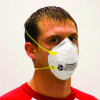Respirator donning in post-hurricane New Orleans
- PMID: 17553247
- PMCID: PMC2738466
- DOI: 10.3201/eid1305.061490
Respirator donning in post-hurricane New Orleans
Abstract
We evaluated correctness of N95 filtering facepiece respirator donning by the public in post-hurricane New Orleans, where respirators were recommended for mold remediation. We randomly selected, interviewed, and observed 538 participants, using multiple logistic regression for analysis. Only 129 (24%) participants demonstrated proper donning. Errors included nose clip not tightened (71%) and straps incorrectly placed (52%); 22% put on the respirator upside down. Factors independently associated with proper donning were as follows: ever having used a mask or respirator (odds ratio [OR] 5.28; 95% confidence interval [CI], 1.79-22.64); ever having had a respirator fit test (OR 4.40; 95% CI, 2.52-7.81); being male (OR 2.44; 95% CI, 1.50-4.03); Caucasian race (OR 2.09; 95% CI, 1.32-3.33); having a certified respirator (OR 1.99, 95% CI, 1.20-3.28); and having participated in mold clean-up (OR 1.82; 95% CI,1.00-3.41). Interventions to improve respirator donning should be considered in planning for influenza epidemics and disasters.
Figures


References
-
- United States Department of Health and Human Services. National Institute for Occupational Safety and Health. 42 CFR Part 84. [cited 2006 Dec 8]. Available from http://www.cdc.gov/niosh/part84.txt
-
- United States Department of Labor. Occupational Health and Safety Administration. Regulations (Standards 29 CFR): Respiratory protection–1910.134. [cited 2006 Dec 8]. Available from http://www.osha.gov/pls/oshaweb/owadisp.show_document?p_id=12716&p_table...
-
- Hannum D, Cycan K, Jones L, Stewart M, Morris S, Markowitz SM, et al. The effect of respirator training on the ability of healthcare workers to pass a qualitative fit test. Infect Control Hosp Epidemiol. 1996;17:636–40. - PubMed
-
- National Institute for Occupational Safety and Health, Centers for Disease Control and Prevention. HETA 99–0363 final report. Cincinnati (OH): The Institute; 1999.
-
- Kao TW, Huang KC, Huang YL, Tsai TJ, Hsieh BS, Wu MS. The physiological impact of wearing an N95 mask during hemodialysis as a precaution against SARS in patients with end-stage renal disease. J Formos Med Assoc. 2004;103:624–8. - PubMed
Publication types
MeSH terms
Grants and funding
LinkOut - more resources
Full Text Sources
Medical
